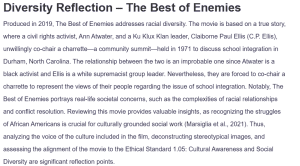Diversity Reflection – The Best of Enemies
Produced in 2019, The Best of Enemies addresses racial diversity. The movie is based on a true story, where a civil rights activist, Ann Atwater, and a Ku Klux Klan leader, Claiborne Paul Ellis (C.P. Ellis), unwillingly co-chair a charrette—a community summit—held in 1971 to discuss school integration in Durham, North Carolina. The relationship between the two is an improbable one since Atwater is a black activist and Ellis is a white supremacist group leader. Nevertheless, they are forced to co-chair a charrette to represent the views of their people regarding the issue of school integration. Notably, The Best of Enemies portrays real-life societal concerns, such as the complexities of racial relationships and conflict resolution. Reviewing this movie provides valuable insights, as recognizing the struggles of African Americans is crucial for culturally grounded social work (Marsiglia et al., 2021). Thus, analyzing the voice of the culture included in the film, deconstructing stereotypical images, and assessing the alignment of the movie to the Ethical Standard 1.05: Cultural Awareness and Social Diversity are significant reflection points.
The movie The Best of Enemies voices the culture of black and white Americans in Durham. On the one hand, Atwater’s character echoes the culture and experiences of the black community in Durham and their demand for equality in a period of systemic racism. Through her role as a civil rights activist, Ann presents the struggles of the black community, such as poor housing (Bissell, 2019) and their demand for social justice in the matter concerning the desegregation of schools. On the other hand, C.P. Ellis voices the perspective of the white community, racial superiority, and their fear of social change. Nonetheless, Ellis’s transformation and support for school integration shows that even deeply rooted racial biases and struggles between two cultures can be overcome through dialogue and mutual understanding.
Further, the movie shows various stereotypes associated with black and white Americans. For instance, Ann is, at first, depicted as aggressive, a label often given to black activists. Nonetheless, her activism is solely driven by a sense of care for her community. She even empathizes with Ellis since he has a sick son, Larry. Larry experiences anxiety about sharing a hospital room with another patient, but the hospital insists that he shares the room (Bissell, 2019). Atwater intervenes and asks a nurse to move Larry to a private room. Second, black people are depicted as incapable and subservient when Ellis questions a white shop owner for hiring a black person as his manager. Ellis later learns that the manager is equally competent as a white person. Further, white Americans are portrayed as inherently racist; the Klan members expect Ellis to be hostile toward black people and vote against school integration. Nonetheless, the charrette exposes Ellis to new perspectives and challenges his biases, making him vote for school integration. Noteworthy, stereotypes exacerbate the misconceptions about a racial group and create the “us versus them” mentality for others outside that culture, making a nexus between the two groups seem impossible.
Moreover, some scenes of The Best of Enemies showcase the NASW Ethical Standard 1.05. Notably, this standard highlights the need for social workers to appreciate the cultural diversity of the individuals they serve. It encourages social workers to engage in continuous education to better understand cultural factors and improve their skills, enabling them to fulfill the needs of individuals from diverse backgrounds (NASW, n.d.). Evidently, the movie reflects this standard through Ann Atwater, who is aware of the various needs of individuals from the black community. Further, at some point, some black youth try to destroy Klan materials presented at the charrette site. Instead, Atwater advises them to read these materials and try to understand the views and perspectives of the white community rather than viewing them as offensive (Bissell, 2019). Accordingly, this demonstrates Atwater’s recognition of the need to appreciate other cultures and reflect on one’s cultural awareness and biases.
In summary, The Best of Enemies presents the complexities of racial relationships between black and white Americans and the unique struggles these racial groups experience. Even so, the movie demonstrates that dialogue and mutual understanding can help close cultural divides.
References
Bissell, R. (Director). (2019, April 5). The best of enemies. STX Entertainment.
Marsiglia, F. F., Kulis, S. S., & Lechuga-Peña, S. (2021). Diversity, oppression, and change: Culturally grounded social work. (3rd ed.). Oxford University Press.
NASW. (n.d.). Ethical Standard of the Month: 1.05 Cultural Awareness and Social Diversity. National Association of Social Workers (NASW). https://www.socialworkers.org/about/ethics/ethics-education-and-resources/ethical-standard-of-the-month/cultural-awareness-and-social-diversity
ORDER A PLAGIARISM-FREE PAPER HERE
We’ll write everything from scratch
Question
Readings:
- Textbook:
- Movie three – The Best of Enemies
Write a two-page reflection paper to review The Best of Enemies.

Diversity Reflection – The Best of Enemies
Must include: the title of the film, year produced, and what area of diversity is addressed.
Please select THREE (or more) key points to address:
- Was the voice of the culture included in the movie/documentary?
- cultural differences than own culture, issues of race, gender issues, religious issues, age discrimination, physical or mental ability or other difference.
- cultural impact of service delivery, significance in social interaction, disadvantages subculture
- challenges on a micro, macro, mezzo level of social work practice and counter those challenges with potential solutions to be explored.
- Identify and deconstruct stereotypical images associated with the racial/ethnic group and how this effects stereotypes on others outside that culture.
- How does the movie/documentary reflect the Ethical Standard 1.05 (Cultural Awareness and Social Diversity). You can review NASW Ethnicity and Race issues at https://www.socialworkers.org/Practice/Ethnicity-Race
- address feelings of how the movie/documentary made you feel.

